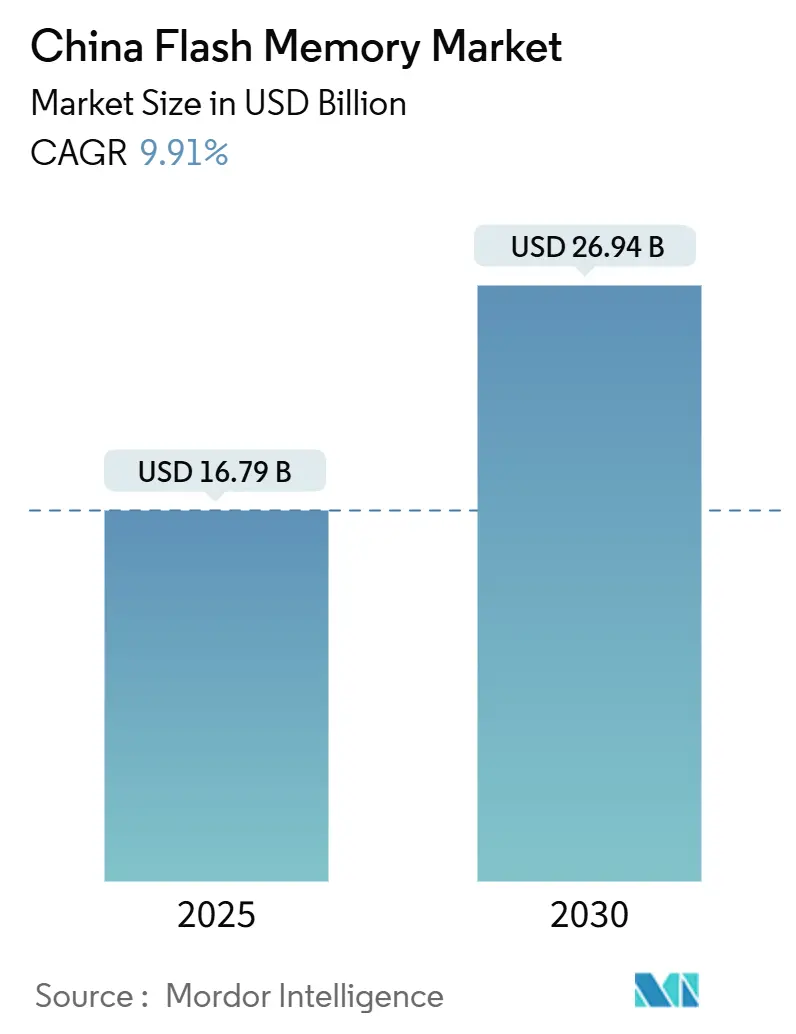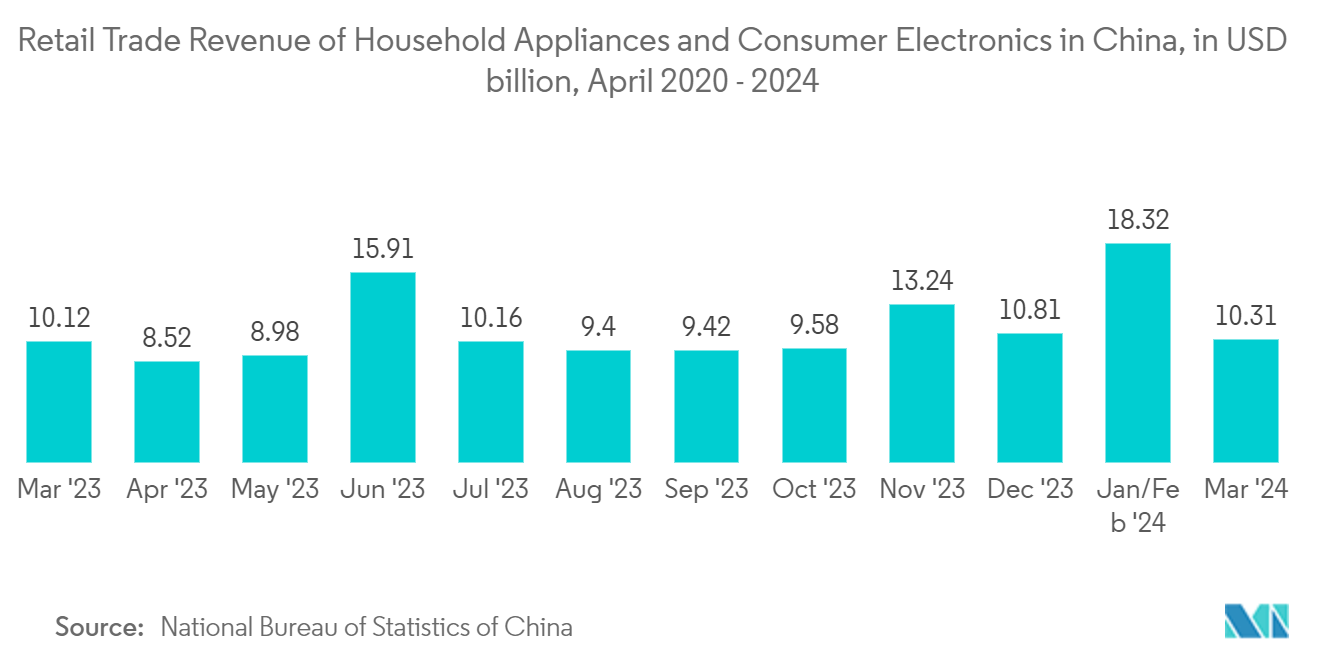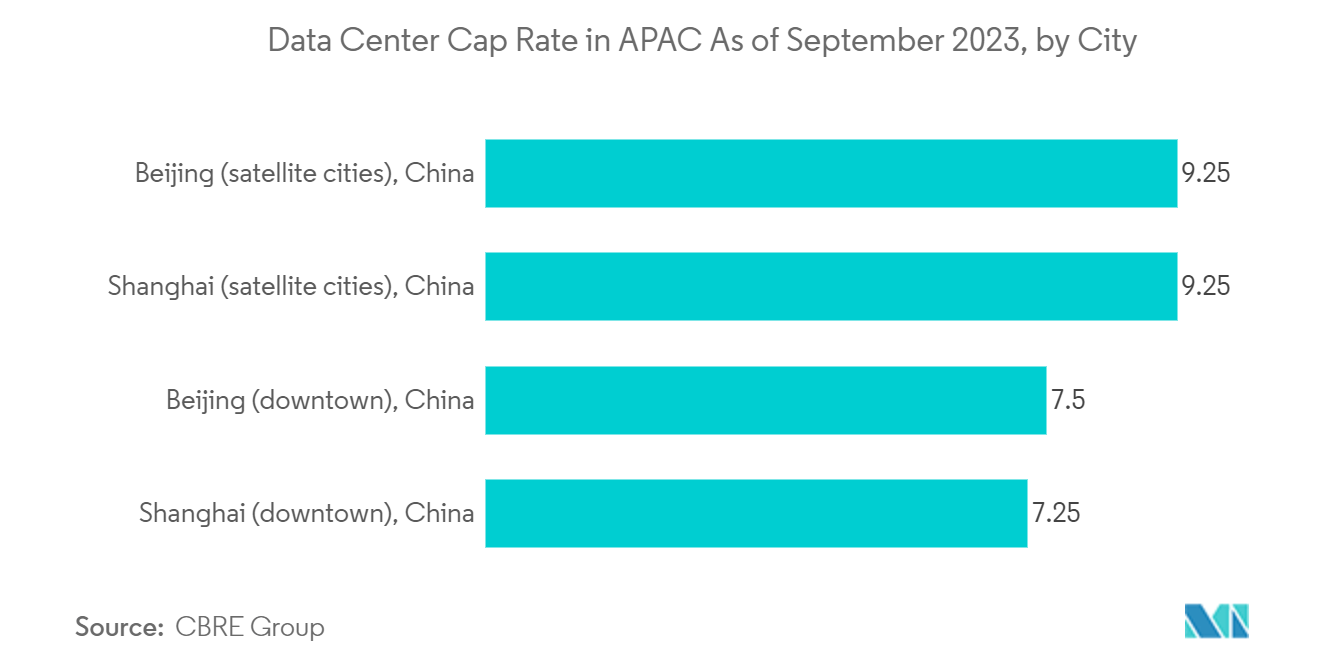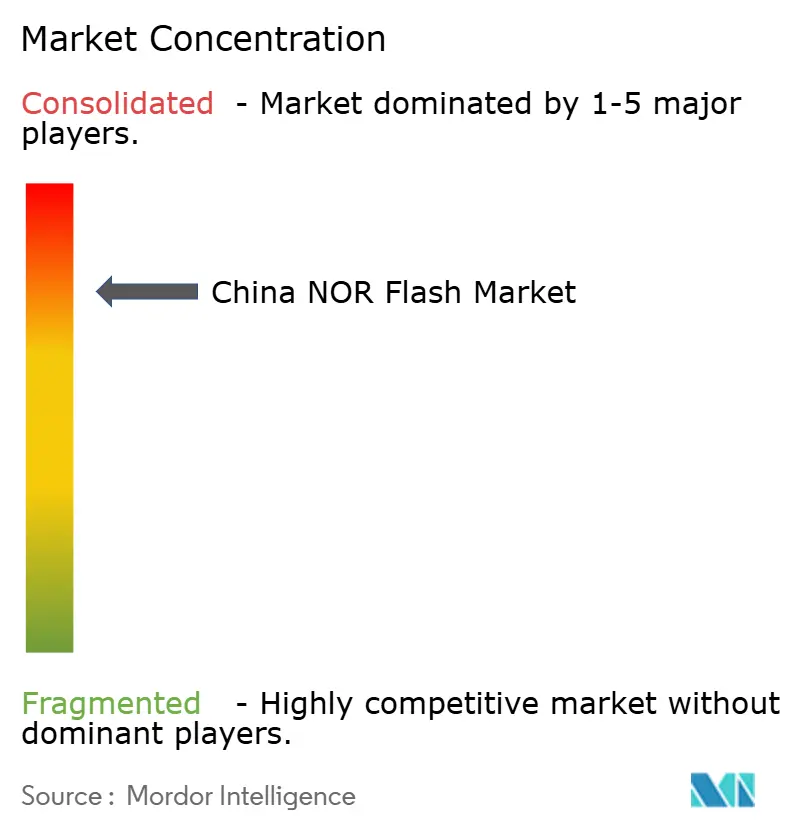China Flash Memory Market Size and Share

China Flash Memory Market Analysis by Mordor Intelligence
The China Flash Memory Market size is estimated at USD 16.79 billion in 2025, and is expected to reach USD 26.94 billion by 2030, at a CAGR of 9.91% during the forecast period (2025-2030).
Moreover, One of the key factors boosting the growth of the China flash market is the increasing popularity of portable electronic devices, combined with the increasing penetration of advanced technologies such as IoT among the Chinese population.
NOR Flash , also known as flash storage, is a nonvolatile that erases and rewrites data at the byte level. Because of their speed and dependability, flash memories, such as SSDs, are gradually replacing hard disc drives (HDDs) in various consumer electronics. The rise of the consumer electronics industry in the region is expected to drive the market.
The Ministry of Industry and Information Technology stated in September 2022 that China ranks first globally in consumer electronics production and sales due to the country's improved innovation and brand-building capacity. Furthermore, China continues to be an essential global manufacturing base for consumer electronics, attracting the world's major electronic producers to establish manufacturing bases and R&D centers. Such factors will result in a sizable device market.
Moreover, the region is seeing several investments and initiatives to improve its production capabilities, one of the factors driving the market. For example, the Chinese government stated in January 2021 that it aimed to increase the domestic market for electronic components to RMB 2.1 trillion (327 billion USD) by 2023. Such government initiatives are anticipated to drive the demand for flash devices in electronic products.
Furthermore, smart watches and smart fitness bracelets are gaining popularity in China as consumers turn to such devices for tracking health as COVID-19 prevention and control measures are optimized. True wireless stereo (TWS) hearable devices are expected to drive significant momentum on NOR Flash among the various IoT applications. China's Ministry of Industry and Information Technology (MIIT) unveiled a five-year plan for smart IoT manufacturing in December 2021, with large manufacturers focusing on digitalization by 2025. Such an initiative is expected to propel the region's consumer IoT electronics market by creating the need to install Flash components.
During the study period, major market players continuously invest in new product launches and other tactical initiatives that boost the market's expansion. For example, China's NOR flash providers, such as Giantec Semiconductor, GigaDevice Semiconductor, and others, are increasing their use in automotive applications to offset a drop in consumer demand.
In addition, the Chinese automotive industry is showing vital signs of recovery in the region, indicating well demand for flash devices such as NOR Flash devices. According to the China Association of Automobile Manufacturers (CAAM), Chinese automakers produced 27.02 million units in 2022, a 3.4% increase over the previous year, while sales increased by 2.1% by 26.86 million units. Such advancements will necessitate using flash products such as NOR Flash for various applications such as infotainment and engine control.
The most common NOR flash substitutes are NAND and DRAM. As a result, one of the market challenges that will limit the growth of NOR Flash sales in the region is the availability of substitutes. Furthermore, the impact of US export bans has caused significant production problems for Chinese chipmakers, limiting market growth.
China Flash Memory Market Trends and Insights
NAND Flash to Hold Major Share
NAND flash is a storage system that stores information or data without power while exhibiting various characteristics such as low power, scalable design, high density, and cost-effectiveness, providing an effective solution for multimedia products on the market. Rising demand for low-cost storage solutions across various consumer electronics applications will be a significant factor driving market growth in the region.
The comparative advantages of NAND flash over its alternatives and the increasing proliferation of 5G and IOT devices are expected to drive market growth. The adoption of 5G technology in many of the same computing applications is expected to increase NAND revenue growth. According to the GSMA, China is expected to be the first market in the world to have one billion 5G connections by 2025. Such factors will drive the device market, including NAND Components.
The region dominates the NAND flash market due to the region's high technological adoption of devices in the consumer electronic devices and enterprise storage sectors. The region is expected to grow significantly during the forecast period due to various factors, such as the increasing proliferation of 5G, IOT devices, and data center investments.
NAND chips are commonly found in cards, USB flash drives, solid-state drives, feature phones, smartphones, and other data storage and transfer products. The growing popularity of smartphones and the increasing use of NAND flash in electronic devices will exacerbate market value.
In February 2022, Samsung announced that it had decided to temporarily adjust operations at its Xi'an manufacturing facilities after Chinese authorities lifted the city's pandemic lockdown. In Xi'an, Samsung employs 3,300 people and operates two fabs that produce 40% of Samsung's total NAND output. The majority of this output is destined for the Chinese market.
Furthermore, in March 2022, Apple Inc. announced that it is looking into new sources of chips for iPhones, including its first Chinese producer, following a disruption at a key Japanese partner that exposed the risks to its global supply. Apple is testing sample NAND flash chips manufactured by Hubei-based Yangtze Technologies Co. Such vendor activities are expected to drive the NAND device market.
YMTC is China's most significant opportunity for dominating the market for 3D NAND chips, in which cells are stacked vertically to increase storage density. China's top chip maker, YMTC, announced in April 2023 that it is making progress in producing advanced 3D NAND products using locally sourced equipment. The increased sourcing of local equipment comes after YMTC received USD 7 billion in new funding from its state-backed investors, including the 'Big Fund.'
With the rise of PCs and smartphones, NAND flash consumption is skyrocketing, much of which can be attributed to the increase in average smartphone capacity. This is expected to drive NAND flash packaging demand, influencing NAND device demand. Despite a crackdown by the Indian government, Chinese smartphones continue to dominate several countries' market share and the Indian market. The market is expected to be driven by such smartphone manufacturing capacity.

Investments in Data Centers to Drive the Market
Some of the most energy-intensive data centers are server farms facilitating communication between users and web services. Most storage servers now use solid-state drives (SSDs), which use flash storage to handle high-throughput data requests at high speeds. SSDs are electronically programmable and erasable microchips with no moving parts. Investments in establishing and developing regional data centers are expected to generate market demand in the region.
Flash storage systems are essential for addressing future storage requirements in enterprises due to high performance, simplified infrastructure deployments, and lower energy and space requirements. Data centers use all-flash arrays and memories to enable optimal application performance in multi-cloud environments.
Many businesses are constantly investing in data center expansion, which will create market opportunities for flash devices used in data center applications. GLP Pte, for example, raised USD 500 million in new funds in February 2022 to help expand its data center platform in China amid rising investor demand for digital infrastructure assets. According to the company, the transaction could value China data centers between USD 4 billion and USD 5 billion. Such investments will propel the market forward.
Moreo CapitaLand announced in February 2023 that it is launching a new China-focused data center development fund and is planning two new facilities outside of Beijing. The two development projects, which will generate more than 100MW, are expected to be completed in 2025. Such vendor investments to maintain a competitive edge in the global digital infrastructure market are expected to create ample opportunities for Flash makers to meet the demand in data centers.
Furthermore, China Mobile announced in December 2022 that it is increasing its investments in Data Centers after gaining over 1,000 Partners. It has also worked with the Chinese Academy of Sciences' Institute of Computing Technology and Peng Cheng Laboratory in Shenzhen to build data center infrastructure. Such investments will propel the nation's data center infrastructure activities, necessitating the installation of flash -based devices.
The growing popularity of new use cases like real-time analytics and artificial intelligence (AI) like machine learning (ML) training or deep learning algorithms is expected to drive up demand for faster storage. The market for flash is expected to grow significantly as demand for fast storage increases due to increased cross-domain data use.
Moreover, increased vendor activity is expected to propel the growth of the flash market, which will cater to the demand for these devices in data center applications. For example, at the Flash Summit (FMS) 2022 in August 2022, YMTC introduced the X3-9070 TLC 3D NAND flash, powered by the Xtacking 3.0 architecture. The X3-9070 from YMTC paved the way for the arrival of more of its 4th generation 3D NAND solutions based on Xtacking 3.0, which will provide even higher NAND throughput, and system-level performance to the company's growing customer base in data centers, enterprise-level servers, PCs, mobile devices, and other applications.

Competitive Landscape
The China Flash market is consolidated, with a few vendors controlling a sizable portion. The key players are Giga Device, YMTC, Macronix, and others. These players use product launches, collaboration, and partnerships, among other strategic initiatives, to gain a competitive advantage in the regional market.
In March 2023, GigaDevice introduced the GD25UF series of SPI NOR Flash in its strategic roadmap of 1.2V Flash products supporting systems-on-chip (SoCs) and applications processors built on advanced function nodes. The GD25UF SPI NOR Flash products are optimized for applications that require ultra-low power consumption or a small board footprint.
In July 2022, Micron Technology, Inc. announced the start of volume production of the world's first 232-layer NAND, which is built with industry-leading innovations to deliver unprecedented storage performance. Micron's 232-layer NAND is a watershed moment in storage innovation because it is the first proof that 3D NAND can be scaled to more than 200 layers in production.
In September 2022, Wuhan XinxinSemiconductor Manufacturing Co. Ltd (therein XMC), one of the leading NOR suppliers, launched XNOR-XM25LU128C, an ultra-small size and low-power SPI NOR Flash product that applies widely to increasingly smaller IoT and wearable devices.
China Flash Memory Industry Leaders
-
Yangtze Memory Technologies Co., Ltd.
-
GigaDevice Semiconductor Inc.
-
Macronix International Co., Ltd
-
Samsung Electronics Co., Ltd.
-
Infineon Technologies AG
- *Disclaimer: Major Players sorted in no particular order

Recent Industry Developments
- February 2023: According to Infineon, China accounted for 36% of the company's revenue in FY2022. The company introduced the SEMPER Nano NOR Flash for battery-powered, small-form-factor electronic devices. Wearable and industrial applications, such as hearables, fitness trackers, health monitors, GPS trackers, and drones, enable more precise tracking, critical information logging, noise cancellation, enhanced security, and other benefits.
- March 2022: Winbond Electronics introduced the W25Q64NE, a 1.2V SpiFlash NOR flash IC with a 64 Mb density. The new NOR flash would give customers a large code storage capacity and active mode power savings according to the latest mobile devices and smart wearables requirements. Compared to equivalent 1.8V devices, the Winbond 1.2V parts reduce active mode power consumption by one-third.
- August 2022: Macronix International Co. Ltd, a leading integrated device manufacturer in the non-volatile (NVM) market, announced that its octa flash MX66UW1G45GXDI00 is providing a critical flash in Renesas' development platform. Designers can use Macronix's high-speed flash and Renesas' latest cost-effective RZ/A3UL microprocessor (MPU) on the new evaluation board to create cutting-edge products.
China Flash Memory Market Report Scope
Flash is a non-volatile electronic computer storage medium that can be erased and reprogrammed electrically. Flash is widely used in embedded systems to store data and code. Unlike traditional hard drives, flash can store data even after the power is turned off. NOR flash and NAND flash are the two main types of flash . Both employ the same cell design, which consists of a floating gate. The market study comprises the value and volume of flash.
The China NOR flash market is segmented by type (NOR flash (by density (2 megabit and less, 4 megabit and less (greater than 2mb), 8 megabit and less (greater than 4mb), 16 megabit and less (greater than 8mb), 32 megabit and less (greater than 16mb), 64 megabit and less (greater than 32mb))), NAND flash (by density (128 mb and less, 512 mb and less, 2 gigabit and less (greater than 1gb), 256 mb and less, 1 gigabit and less, 4 gigabit and less (greater than 2gb))), by end user (data center(enterprise and servers), automotive, mobile and tablet, client (PC, Client SSD)). The report offers the market size in value terms in USD for all the abovementioned segments.
| NAND Flash | By Density | 128 MB and LESS |
| 512 MB and LESS | ||
| 2 GIGABIT and LESS (greater than 1GB) | ||
| 256 MB and LESS | ||
| 1 GIGABIT and LESS | ||
| 4 GIGABIT and LESS (greater than 2GB) | ||
| NOR Flash | By Density | 2 MEGABIT and LESS |
| 4 MEGABIT and LESS (greater than 2MB) | ||
| 8 MEGABIT and LESS (greater than 4MB) | ||
| 16 MEGABIT and LESS (greater than 8MB) | ||
| 32 MEGABIT and LESS (greater than 16MB) | ||
| 64 MEGABIT and LESS (greater than 32MB) |
| Data Center (Enterprise and Servers) |
| Automotive |
| Mobile and Tablets |
| Client (PC, Client SSD) |
| Other End-user Applications |
| By Type | NAND Flash | By Density | 128 MB and LESS |
| 512 MB and LESS | |||
| 2 GIGABIT and LESS (greater than 1GB) | |||
| 256 MB and LESS | |||
| 1 GIGABIT and LESS | |||
| 4 GIGABIT and LESS (greater than 2GB) | |||
| NOR Flash | By Density | 2 MEGABIT and LESS | |
| 4 MEGABIT and LESS (greater than 2MB) | |||
| 8 MEGABIT and LESS (greater than 4MB) | |||
| 16 MEGABIT and LESS (greater than 8MB) | |||
| 32 MEGABIT and LESS (greater than 16MB) | |||
| 64 MEGABIT and LESS (greater than 32MB) | |||
| By End User | Data Center (Enterprise and Servers) | ||
| Automotive | |||
| Mobile and Tablets | |||
| Client (PC, Client SSD) | |||
| Other End-user Applications | |||
Key Questions Answered in the Report
How big is the China Flash Memory Market?
The China Flash Memory Market size is expected to reach USD 16.79 billion in 2025 and grow at a CAGR of 9.91% to reach USD 26.94 billion by 2030.
What is the current China Flash Memory Market size?
In 2025, the China Flash Memory Market size is expected to reach USD 16.79 billion.
Who are the key players in China Flash Memory Market?
Yangtze Memory Technologies Co., Ltd., GigaDevice Semiconductor Inc., Macronix International Co., Ltd, Samsung Electronics Co., Ltd. and Infineon Technologies AG are the major companies operating in the China Flash Memory Market.
What years does this China Flash Memory Market cover, and what was the market size in 2024?
In 2024, the China Flash Memory Market size was estimated at USD 15.13 billion. The report covers the China Flash Memory Market historical market size for years: 2019, 2020, 2021, 2022, 2023 and 2024. The report also forecasts the China Flash Memory Market size for years: 2025, 2026, 2027, 2028, 2029 and 2030.
Page last updated on:
China Flash Memory Market Report
Statistics for the 2025 China Flash Memory market share, size and revenue growth rate, created by Mordor Intelligence™ Industry Reports. China Flash Memory analysis includes a market forecast outlook for 2025 to 2030 and historical overview. Get a sample of this industry analysis as a free report PDF download.
.webp)


